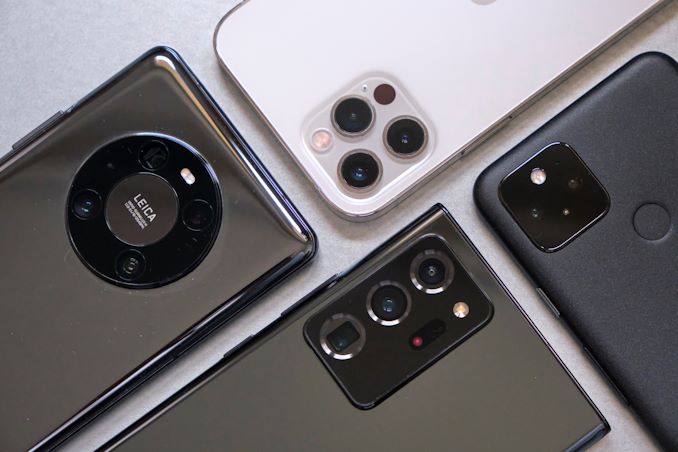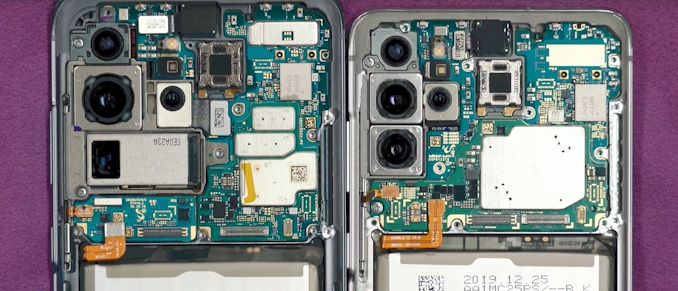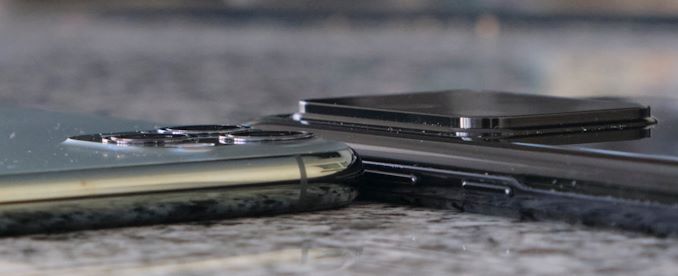AnandTech Year In Review 2020: Flagship Mobile
by Andrei Frumusanu on December 28, 2020 8:00 AM EST- Posted in
- Mobile
- Apple
- Samsung
- Smartphones
- Huawei
- SoCs
- OnePlus
- Year In Review

We’re a few days away from completing the 2020 calendar year, and it’s been a quite a hectic year for everybody. In times of troubles, the smartphone industry had been under a two-prong attack from both an economic stand-point as well as the from a product maturity standpoint – trying hard to innovate with new features to convince users to upgrade their previous generation devices. This year, we’ve seen several new industry trends make breakthrough advances in terms of technology in smartphones, beyond the obvious elephant in the room, by which 2020 will be remembered by: Big camera sensors, 120Hz displays, several large SoC moves, 5G, and several other vendor product choices.
Big Sensors go Mainstream
Although a subjective opinion, what I view as one of the most important developments in 2020 mobile devices has been the widespread adoption of larger camera sensors. While in years past, Huawei had been the notable exception to the rule in terms of adopting larger camera sensors in their smartphones, this year, we’ve seen almost everybody make the transition to larger formats – either 1/1.78” sensors or even the new humongous 1/1.33” beasts in some flagships.

Galaxy S20 Ultra & Galaxy S20+
Bigger sensors most of the time means that vendors are able to use bigger pixels – which in turn results in better dynamic range capability and better low light captures. This year we’ve seen many flagships at least adopt a 1/1.78” sensor which is notably larger than previous generation 1/2.3” or 1/2.5” units – resulting in 12MP 1.8µm pitch units like on the new S20 series and some other vendors such as Sony.
Other vendors have opted to go even bigger – ranging from 1/1.3” to 1/1.4” sensors. The most notable and talked about has been Samsung’s new 108MP units in the S20 Ultra and Note20 Ultra series. Although the high-pixel count sensors deployed on these devices have questionable benefits in their native resolution, the ability to bin 3x3 pixels down to an 12MP image means we’re looking at effective light gathering capabilities similar to that of a 2.4µm pixel pitch sensor, something well beyond other current sensors on the mobile market.
We’ve seen variations of these huge sensors – Xiaomi also uses a 108MP native unit but bins down by 2x2 to a 27MP capture mode in general use-cases, while OnePlus had opted for a slightly smaller 1/1.4” sensor in the OnePlus 8 Pro with a 48MP native resolution, binning down to 12MP.
The big caveat with these big sensors is their optics systems – many times the plastic lenses can’t keep up with the resolution of the sensors, partly negating some of their characteristics, making much of the 108MP contenders relatively gimmicky in real-world scenarios.

iPhone 11 Pro vs Galaxy S20 Ultra
The other big issue with larger sensor sizes is that they require a larger z-height of the camera module, which means larger camera bumps. And oh boy, we did get some really funky looking camera bumps in this year’s devices, such as the massive design element on the S20 and Note Ultras.
Related Reading:
- Xiaomi’s Mi Note 10 Family: World’s First Smartphones with 108 MP Penta Camera Array
- Samsung Unveils ISOCELL Bright HMX 108 MP Sensor for Smartphones
- The Samsung Galaxy S20+, S20 Ultra Exynos & Snapdragon Review: Megalomania Devices
- The OnePlus 8, OnePlus 8 Pro Review: Becoming The Flagship
- Xiaomi Globally Launches Mi 10, Mi 10 Pro; Snapdragon 865 & 108MP Cameras
- The Xiaomi Mi 10 Pro Review - A Solid Overall Value
- Samsung Announces New 50MP Dual-Pixel and Quad-Bayer ISOCELL Sensor
120Hz, An Almost Must
Another big development this year has been the mainstream adoption of high refresh rate display panels. While in 2019 90 or 120Hz displays were exotic or reserved for special gaming-oriented phones, in 2020 it could be said that it was a checkmark feature for almost every vendor, essentially eliminating 60Hz from almost all new product releases bar the mid-range or low-end.
Though 120 and 90Hz displays this year certainly have augmented the fluidity and user experience of flagship devices, only the Note20 Ultra was the one device which was able to adopt this with relatively few drawbacks, thanks to its new polycrystalline and oxide panel technology. For the rest of the market, 120Hz came with a relatively larger battery impact, meaning the new fluidity came with a device longevity compromise.
For 2021, I see more vendors adopt the new 120Hz feature in a more optimised manner that improves upon the battery consumption, maturing the technology to a point where it becomes a no-brainer to have it enabled by default.
Related Reading:
- The Samsung Galaxy S20+, S20 Ultra Exynos & Snapdragon Review: Megalomania Devices
- The OnePlus 8, OnePlus 8 Pro Review: Becoming The Flagship
- The ASUS ROG Phone III Review: A 144Hz 6000mAh Beast With Caveats
- Samsung's Note20 Ultra Variable Refresh Rate Display Explained
Exynos Core Death (& Revival?)
Continuing with our takes on key hardware component changes in 2020, one large move has been Samsung’s abandonment of their custom CPU cores in their Exynos chipsets. Struggling with power efficiency and performance competitiveness for several years now, Samsung LSI finally cut the cord on their custom CPU core design project and team, opting to instead fully rely on Arm’s future Cortex CPU IP for next-generation Exynos SoCs.
We had been covering Samsung’s cores in detail for several years now, and it’s unfortunate to say that the project’s cancellation is likely the best-case scenario for future Exynos SoCs, dropping one of the chip’s most negative aspects – and in turn likely result in significantly better designs in 2021, hopefully eliminating some of the performance and power efficiency differences between Snapdragon and Exynos Galaxy phones.
Related Reading:
- Samsung Announces Exynos 990: 7nm EUV, M5, G77, LPDDR5 Flagship SoC alongside Exynos 5123 5G Modem
- The Samsung Galaxy S20+, S20 Ultra Exynos & Snapdragon Review: Megalomania Devices
- ISCA 2020: Evolution of the Samsung Exynos CPU Microarchitecture
- Samsung Announces Exynos 1080 - 5nm Premium-Range SoC with A78 Cores
- Samsung Teases CES Announcement For Next Exynos SoC
MediaTek Dimensity Resurgence
2020 marked MediaTek’s re-entry into the high-end SoC market, introducing the new Dimensity 1000 SoC. Although the new design was off to an extremely slow start with very few design wins in the first half of the year, the company’s efforts in the mid-range Dimensity series has results in a large amount of design wins, and according to Counterpoint Research, allowed the company to actually position itself as the #1 SoC vendors in Q3 2020, taking market share from the likes of Qualcomm.
We had reviewed the Dimensity 1000 inside of the OPPO Reno3 5G and found it to be an excellent SoC in terms of performance and efficiency – what’s really lacking though is a more prestigious high-volume design win that has more visibility. Hopefully MediaTek manages to achieve such a design in 2021.
Related Reading:
- MediaTek Announces Dimensity 1000 SoC: Back To The High-End With 5G
- CES 2020: MediaTek Announces New Dimensity 800 Mid-Range 5G SoC
- MediaTek Announces Dimensity 1000+ SoC
- MediaTek Announces Dimensity 820 Mid-Range SoC With More Performance
- OPPO's Reno3 5G vs Reno3 Pro vs Reno3 Pro 5G: Why Don't We See More MediaTek Dimensity 1000 Phones?
5G for Most
While 5G has been a premium “the new thing” feature in some 2019 devices, it can be said that it’s really in 2020 where the new cellular communication standard has really been adopted as a mainstream technology in new smartphone products. Almost every new Android flagship device has had 5G as a selling point in 2020, and with Apple’s release of 5G-only iPhone 12 series, we can pretty much say we’ve made a turning point between 4G and 5G.
Although cellular networks in many countries are still in deployment and it’ll probably be a few years before 5G becomes ubiquitous for everybody, buying a 4G device today is no longer the best long-term investment unless you’re really looking at low-end devices. 5G also has trickled down to the premium and mid-range thanks to the likes of SoCs such as the Snapdragon 765 – with 2021 projected as being the year where we’ll also see the $250 device market also adopt 5G connectivity.












56 Comments
View All Comments
Revv233 - Saturday, January 2, 2021 - link
Love my "small" sony 5.2First no compromise since galaxy S9.
Wish it had S9 camera though.
iphonebestgamephone - Monday, December 28, 2020 - link
The wider aspect ratio has been helpful for games, more space for all the onscreen buttons and ui elements, along with the wider view. Also movies.iphonebestgamephone - Monday, December 28, 2020 - link
Oh, it also makes split screen experience better.iphonebestgamephone - Monday, December 28, 2020 - link
Its even been useful for some excel docs, now that i remember.eastcoast_pete - Monday, December 28, 2020 - link
Andrei, whenever you have a chance, I'd appreciate a reasonably deep dive into the differences in onboard storage tech and the impact on a phone's speed, response in daily use etc. I believe Apple is still the only phone maker that uses NVMe storage, while all Androids seem to use some version of UFS. Why is that, and how much faster is NVMe if used in smartphones (assuming it still is)? Thanks!RSAUser - Saturday, January 2, 2021 - link
UFS 3.0 and iPhone Nvme are about matched with UFS3.0 usually being slightly faster sequentially, and then UFS 3.1 being a good 10 faster on average.The difference really isn't that much though, both are plenty fast.
Do note it's not Nvme on iPhone, it's the mobile version which caps at 1.1GBps.
Cod3rror - Monday, December 28, 2020 - link
Larger camera sensors, 5G and 120Hz screens have all been good, meaningful upgrades.For 2021, I would really like for even larger sensors. Can they reach the golden 1" sensor size?
I hope they keep 120Hz screens and not go higher than that. Screen sample rates should increase though; the higher, the better. And flat, go back to FLAT screens!
If the new 5G chips are more battery efficient that'll be great!
Other than that I don't really know what they could bring that would be innovative and compelling people to upgrade. I don't care about under-the-screen front cameras at all personally. I am only interested in bigger camera sensors.
FunBunny2 - Monday, December 28, 2020 - link
"5G!! We don't need no stinkin 5G!" You really should have delineated two simple facts:1 - mmWave 5G, the only real 5G, exists essentially nowhere
2 - what is advertised as '5G' is not much more than LTE
That phone vendors are conspiring with carriers to dupe the sheep is bad enough. For you to not call them out for it... isn't that your job?
Andrei Frumusanu - Monday, December 28, 2020 - link
Calling mmWave real 5G is complete nonsense. Sub-6 is of magnitudes more important to the increase in spectrum and bandwidth, and has significant benefits over LTE.mmWave will always remain a niche due to how it works.
Bp_968 - Monday, December 28, 2020 - link
I think most people assume mmWave *is* 5G because they marketed 5G using *big numbers* because it sells. Except mmWave is required for those big numbers. From what ive read the sub6 changes mainly benefit carrying capacity and customer load issues. So while yes, it will improve speed and consistency for people in dense environments, it won't necessarily improve their top end speed and isn't as easily marketable as showing a speed test window and saying "wow! GIGS!!!"Which never made much sense to me anyway. I am a massive abuser of bandwidth on my PC and have GB fiber at home, but on my phone ive never wished I had more bandwidth.